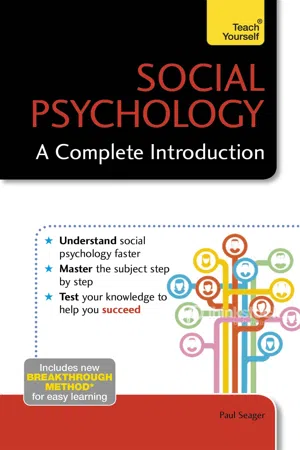
- 256 pages
- English
- ePUB (mobile friendly)
- Available on iOS & Android
Social Psychology: A Complete Introduction: Teach Yourself
About this book
Written by Dr Paul Seager, a social psychology specialist who teaches at the University of Central Lancashire in Preston, Social Psychology: A Complete Introduction is designed to give you everything you need to succeed, all in one place. It covers key areas that students are expected to be confident in, outlining the basics in clear jargon-free English, and then provides added-value features like summaries of key studies, lists of questions to test your understanding of the concepts covered, and a 'Food for thought' section at the end of each chapter which challenges you to put the academic theories to practical use.The book uses a structure that mirrors many university courses on social psychology - starting off by explaining what social psychology is and how it is researched, before exploring a wide variety of the fascinating areas social psychologists have looked at in both classic and lesser-known studies. Areas covered include: the self; attributions; social cognition; interpersonal attraction; social influence; attitudes and persuasion; prosocial behaviour; aggression; groups; leadership; group decision making; intergroup behaviour; and prejudice. A final chapter looks at how social psychology can, and has been, applied in the real world to make a difference.'Teach Yourself' titles employ the 'Breakthrough method', which is designed specifically to overcome problems that students face. - Problem: "I find it difficult to remember what I've read."; Solution: this book includes end-of-chapter summaries and questions to test your understanding.
- Problem: "Most books mention important other sources, but I can never find them in time."; Solution: this book includes fully referenced quotes ready to use in your essay or exam, and each chapter lists further suggested readings for each topic.
- Problem: "Lots of introductory books turn out to cover totally different topics than my course."; Solution: this book is written by a current university lecturer who understands what students are expected to know.
Frequently asked questions
- Essential is ideal for learners and professionals who enjoy exploring a wide range of subjects. Access the Essential Library with 800,000+ trusted titles and best-sellers across business, personal growth, and the humanities. Includes unlimited reading time and Standard Read Aloud voice.
- Complete: Perfect for advanced learners and researchers needing full, unrestricted access. Unlock 1.4M+ books across hundreds of subjects, including academic and specialized titles. The Complete Plan also includes advanced features like Premium Read Aloud and Research Assistant.
Please note we cannot support devices running on iOS 13 and Android 7 or earlier. Learn more about using the app.
Information


 | Key idea: Hypothesis |

 | Key idea: Independent variable (IV) |

 | Key idea: Dependent variable (DV) |

Table of contents
- Cover
- Title
- Dedication
- Contents
- Introduction
- 1 Doing research in social psychology
- 2 The Self
- 3 Attributions
- 4 Social cognition
- 5 Interpersonal attraction: liking and loving
- 6 Social influence: conformity and obedience
- 7 Attitudes and persuasion
- 8 Prosocial behaviour
- 9 Aggression
- 10 An introduction to groups
- 11 Group processes
- 12 Leadership
- 13 Prejudice
- 14 Intergroup relations
- 15 Social psychology in action
- Answers
- References
- Copyright